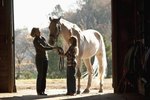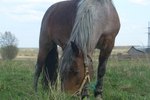
An equine sling isn't something most people have stored in their barns. They're expensive, and few horse owners would ever need one. When it is needed, though, the sling can make the difference between life and death for a horse requiring rescue or recuperating from illnesses or foot and leg issues. That's why equine veterinary practices, rescue groups and even first responders might have slings on hand.
Equine Slings
A professionally designed sling correctly supports the horse's skeletal structure. Slings are available in various sizes, able to support animals weighing more than 1,000 pounds to foals or ponies. Slings come with attachments, such as leg supports, for the needs of horses in specific situations.
Rescue
In rescue, slings are used when all other options to get a horse out of a dangerous situation are exhausted. Rescuing a trapped horse requires professionals, educated in using the equipment and safety procedures. "Slings should be used only as a last resort when a ground rescue is not possible,” as the website Hoof Mechanics puts it. Depending on where the horse has fallen, a helicopter might be necessary to rescue the horse once it is placed in a sling.
Recuperation
Horses recovering from injuries who can't bear weight on their limbs benefit from sling use. The amount of time a horse needs to stay in the sling, inside a stall, depends on the nature of the injury and his reaction to the sling. Horses with neurological issues might also be placed in slings to avoid injury.
Recumbency
Horses are prey animals who spend relatively little time each day sleeping on the ground. It's not uncommon for an aged or sick horse to find itself unable to get up from a recumbent position or stay up. If you can't safely get your horse up yourself, you might require the services of a veterinarian or large-animal rescue using a sling. The procedure isn't that different from saving a trapped horse, although the recumbent horse is generally in a field or stall, not a remote, dangerous area.
Anesthesia Recovery
If your horse undergoes surgery, your vet might place him in a sling temporarily while he recovers from general anesthesia. Horses often injure themselves while recovering from anesthesia, including breaking bones, so veterinary surgical facilities place them in padded stalls. Putting horses in a sling prevents them from hurting themselves until the anesthesia is out of their system.
Starvation
Horses rescued from starvation situations might be too weak to stand. Bringing a starved horse back from the brink is always risky, requiring veterinary attention along with people knowledgeable about correct feeding of a starved equine. Putting the animal in a sling until it regains enough strength to stand on its own can make a difference regarding survival.
References
- Anderson Sling: The Anderson Sling/Veterinary Sling
- Hoof Mechanics: Large Animal Slings
- International Veterinary Information Service: How to Lift Recumbent Equine Patients in the Field and Hospital With the UC Davis Large Animal Lift
- Vet Contact: Anderson Sling Suspension System for Horses after General Anesthesia
- American Humane Association: Starving Horse Response (Maryland)
Resources
Photo Credits
-
Digital Vision/Digital Vision/Getty Images
Writer Bio
Jane Meggitt has been a writer for more than 20 years. In addition to reporting for a major newspaper chain, she has been published in "Horse News," "Suburban Classic," "Hoof Beats," "Equine Journal" and other publications. She has a Bachelor of Arts in English from New York University and an Associate of Arts from the American Academy of Dramatics Arts, New York City.




